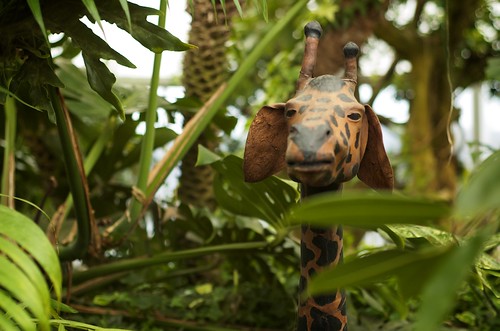
© 2010 Simon Hucko
Today I'm going to talk a bit about how I go about taking photos. This article mainly applies to the DSLR users out there, so sorry to the point n shoot peeps. Before you leave, I will say that I'm a big fan of pre-focusing on the subject and then recomposing the photo. I talked about this a bit in my article about fighting shutter lag, which is worth another read.
To those of you with the big bulky black boxes slung around your neck, I'll share a technique I got hooked on last fall. By default, your camera is set up to look at all of the available focus points, pick the one that it thinks is the subject, lock focus with a half-press of the shutter, and then once focus is confirmed it will trip the shutter on a full press. This method works most of the time, but you're going to run into plenty of cases where it will drive you bonkers. Take my photo today - if I had let the camera do all the focusing automatically, it probably would have grabbed onto one of the leaves in the foreground, and I would have ended up with a nice out of focus giraffe. I long ago turned off all the fancy focus features and use just the center focus point - I choose what I want to be in focus, lock focus, and then adjust the photo for the framing I want. This technique (called focus then recompose) is nothing new, and I would guess is what most of you already use.
The juicy little tidbit I want to share with you today is the AF-ON button. "Huh? I don't have an AF-ON button on my camera." Well, no, unless you own a pro or prosumer camera (D# or D### series for you Nikon shooters), you don't. But you do have a little button on the back marked "AE-L/AF-L," and you probably never use it. (For the Canon users out there, I'm not sure exactly what the buttons are and where they're located, but I'm sure it's something similar.) Lucky for you, that button can be re-mapped to AF-ON through the custom settings menu. Check your manual to see how this is done for your camera.
Why would you want to do this? There are a few reasons. The one that did it for me was not having to hold the half-press on the shutter to keep the focus lock. I would focus then recompose and wait for the right moment, all the while holding that half-press. If I slipped a little bit, the camera would unlock and then re-focus, screwing everything up and causing me to have to start over. Even if it worked, sitting there holding a half-press can get uncomfortable after a few seconds, and I have better things to worry about. Another huge benefit is that you can set your focus mode to AF-C (continuous servo mode), which means that your shutter will never wait for focus confirmation to fire. I've had a few situations where I had the shot framed and in focus, but the shutter just wouldn't trip because the camera thought I screwed up. There is nothing more frustrating than mashing your finger down on the shutter release and having nothing happen. Another great thing about this is that you can use the AF-C to track your subjects right up to when you fire the shutter. No more switching back and forth between focus modes, you get all of the benefits of both without any of the drawbacks. The final big advantage for me is that I can shoot a series of shots without having to re-focus every time. If I'm working on a subject a set distance away, I can focus once and work on different framing, adjust exposure, or capture different moments, all without having to re-focus every time I half-press the shutter.
This may sound a little strange, and I was skeptical at first too. It'll even feel a little weird the first time out, and you'll miss a lot of shots because you'll forget to focus (don't try this for the first time at an important event or paid gig). However, you'll get used to it pretty quickly, and if you're a focus-then-recompose type shooter you're going to love it.
~S
[title of blog] on flickr
![[title of blog]](https://blogger.googleusercontent.com/img/b/R29vZ2xl/AVvXsEhJ8bvx_9_zOAREbXcrJRML7aVvJMbb90IYYYuyti384jeZHYQ9t8MK6_Kpt_1P4-pZw-QfF9kh4Sqci0vbopzLme862PPhuyPJcc7pRLUW1K1aNzts5YzuXIhgonq66MpjJCqfiWtfwUw/s1600-r/waterfall.png)




No comments:
Post a Comment